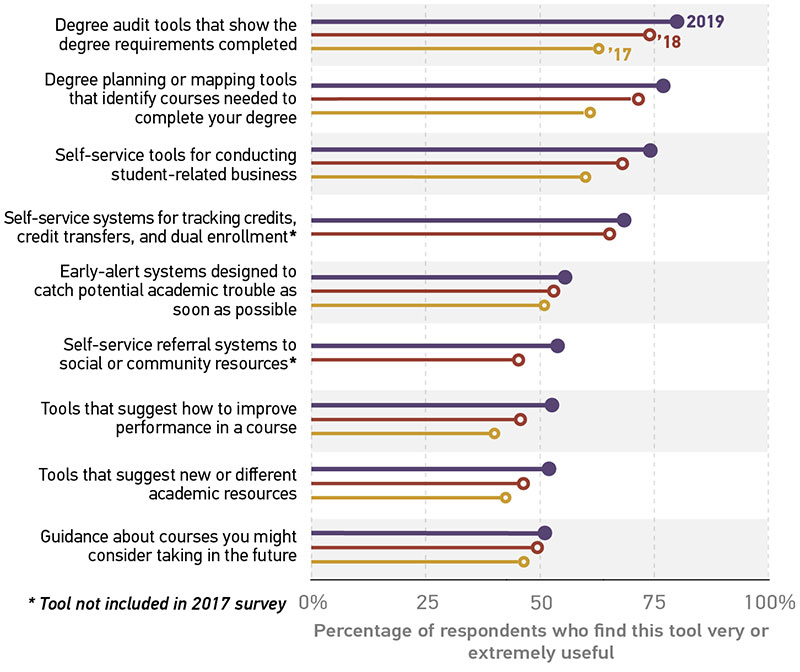Student Success Tools
Online tools help students navigate their college experience.
Our data suggest that online student success tools at colleges and universities are valuable to many of the students who use them. Like a college-specific GPS, these tools can help students map degree paths, navigate enrollment and business systems, identify roadblocks that can cause academic breakdowns, and find service points and resources along the way.
Students who used their institution's online success tools1 ranked "degree audit tools that show the degree requirements completed" as the most useful (80% rated them very or extremely useful). "Degree planning or mapping tools that identify courses needed to complete a degree" came in second (77%), followed by "self-service tools for conducting student-related business" (74%). We also observed incremental increases in the positive ratings of all the online tools included in the survey since 20172 (figure 3), with students finding them each a little more useful than the year before. Although a few tools saw only a slight bump in positive assessments over the past two years, others experienced gains of 10 percentage points or more. This gradual growth, albeit marginal for some tools, suggests that many students see online success tools as increasingly valuable in traversing their college experience.

The tools that saw the largest gains in usefulness between 2018 and 2019 include "self-service referral systems for social or community resources," such as community events and crisis counseling (up from 45% to 54%), and tools that "suggest how to improve performance in a course" (an increase from 45% to 53%). Similar to last year, our results also suggest that students in some groups found tools that aid in academic success more helpful than their peers did. For example, nonwhite students reported significantly higher ratings of usefulness for tools that suggest how to improve performance in a course than their white peers. The significant increase in usefulness ratings for self-service referral systems for social and community resources is particularly heartening news for at-risk students and those in crisis, especially in light of the rising rates of student mental health conditions such as depression and anxiety.3 If students find these tools helpful, then they may be more likely to tap counseling and other community resources when they are most needed, and these services can be vital in supporting student mental and physical wellbeing.
IT units can use these data as motivation to continue efforts to communicate the usefulness of online tools to students, faculty, and advisors. Research has shown that for some institutions that have undertaken iPASS (Integrated Planning and Advising for Student Success) initiatives, advising tools are having an impact in the form of increased retention4 and a rise in staff collaboration and advising appointments for students.5 But effective implementation of these systems is key to favorable outcomes and long-term results. Education and training, buy-in, and institutional capacity for successful implementation are all needed, so institutions should be prepared to address these areas. A top-down approach is not likely to be enough to put these tools into action. Gaining insight into what is needed, used, and unnecessary from key stakeholders—students, faculty, and advisors—is an initial step in assessing how best to leverage these resources for student success.6
IT organizations might also consider exploring the use of success tools with predictive analytics, which have helped some institutions improve grades and graduation rates for at-risk students, as well as increase minority enrollment and completion of STEM programs.7 However, colleges and universities should also be aware of the risks that can come with the use of predictive analytics, from issues related to false positives and data errors, to student privacy and bias.8 When implemented thoughtfully, responsibly, and as a supplement to—not a replacement for—the guidance and support of trained student advisors, online success resources can be part of the larger college toolkit to help students stay on the road that leads to academic achievement and graduation.
Notes
-
Respondents were first asked how frequently, if at all, they had used nine online success tools provided by their institution. Only students who responded that they had used the service(s) were directed to the question that asked them to rate the usefulness of the services they used.
↩︎ -
The tools "Self-service systems for tracking credits, transfers, and dual enrollments" and "Self-service referral systems to social and community resources" were not included in the 2017 student survey but were added to the list of tools in the 2018 survey instrument.
↩︎ -
Gregg Henriques, "The College Student Mental Health Crisis (Update)," Psychology Today, November 18, 2018.
↩︎ -
John O'Brien, "Making the Case for Student Success Technology," EDUCAUSE Review, September 24, 2018.
↩︎ -
Alexander Mayer, Hoori Santikian Kalamkarian, Benjamin Cohen, et al., "Integrating Technology and Advising: Studying Enhancement to Colleges' iPass Practices," MDRC, July 2019.
↩︎ -
Ibid.
↩︎ -
Jean Dimeo, "Data Dive: Georgia State's Extensive Predictive Analytics Efforts Are Leading to Better Grades and Student Retention—and More Minorities Graduating from STEM Programs," Inside Higher Ed, July 19, 2017.
↩︎ -
Jill Barshay and Sasha Aslanian, "Colleges Are Using Big Data to Track Students in an Effort to Boost Graduation Rates, but It Comes at a Cost," The Hechinger Report and American Public Media, August 6, 2019.
↩︎